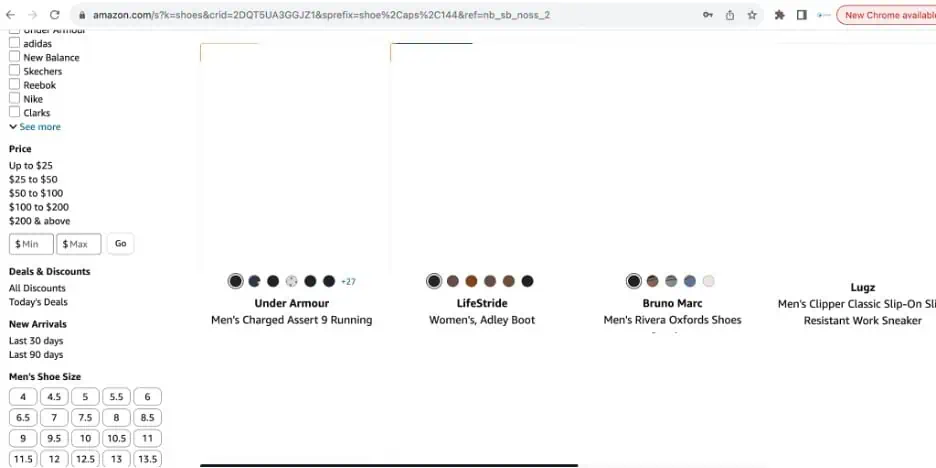Are you an Amazon addict? The sort of person who always has stacks of brown boxes piling up outside their door? If so, you are far from alone. As of 2023, 67% of all American households have an Amazon Prime subscription, and Amazon owns 38% of the e-commerce market in the US.
It’s easy to see why the online marketplace is so popular. Simply by searching for a pair of shoes within an intuitive user interface, users are given a seemingly limitless amount of choices each with prices, photos, measurements, and any other metric a shopper could desire.
Would Amazon be successful without giving users an abundance of data? Imagine trying to find shoes in an unintuitive Amazon. There’d be no photos, no prices, nothing except a terse description.
All you can do is try to decipher perplexing descriptions to try to visualize or remember product details like image and price, take a leap of faith by ordering one, and discover a pair of oversized, overpriced slippers dropped on your doorstep a few days later.
As preposterous as this thought experiment seems, it is the reality of procurement departments in manufacturing firms across the United States. Worse yet, their responsibilities are far more important than purchasing a pair of sporty sneakers.


The Procurement Predicament
Procurement professionals need to secure thousands of parts for many different products at the best price possible for their company. Getting overcharged or ordering the wrong part can be the difference between profit and loss.
Worse yet, as long-time professionals retire, getting the right part at the right price will become even more challenging. This difficulty stems not merely from a lack of memory, but from a lack of familiarity with parts never encountered before.
Without centralized methods of storing data, when workers leave manufacturing companies, key insights and manufacturing depart with them. This leaves new employees in a bind, struggling to ensure a steady influx of parts.
To manufacturing professionals, this may seem natural, even inevitable. But manufacturing can improve the procurement process, along with company-wide efficiency, by ‘Amazon-ifying’ their internal records of drawings.
Bringing the Amazon Online User Experience to Procurement
What might an Amazon-ified system look like? And how would it help firms strengthen their bottom line? Instead of drawings, sales data, and various records being scattered across the organization, they would all be centralized in one software system. Anyone could search through the directory and find a page containing drawings, prices, and other information about a specific part.
Within procurement departments, the current model outlined above would melt away in favor of an intuitive and easy-to-search interface. This would transform procurement professionals’ work and improve efficiency drastically.
Instead of calling up suppliers, procurement officials would have immediate access to the prices of competing products. This would enable them to find bargains that would have otherwise been invisible.
Additionally, suppliers will have a more holistic understanding of the value of what they’re paying for. Two I-beams may be priced the same but having access to drawings, photos, and other additional information could reveal significant pricing inconsistencies that can be fixed with replacing a supplier or changing the design.
For example, one type of steel material might have been cheaper at one point due to raw material price fluctuations and a new material might yield significant cost reduction.
It’s Not Only Procurement That Benefits From Being “Amazon-ified”
Successfully implementing such a system would reverberate beyond procurement. Engineering and fabrication would stand to benefit from having a centralized, easy-to-navigate record of all the pieces and parts a given company has ordered or developed.
In many engineering departments across major manufacturers, schematics and critical knowledge are scattered across filing cabinets, various services, or, worst of all, employees’ minds.
Engineers can spend hours trying to recover lost files. Sometimes, this process is so time-consuming that it is simpler to start again and make a new drawing from scratch. When critical engineers leave, the problem grows even more acute. These workers can know critical information about products. So, when they walk out the door, a part of the company’s product leaves with them.
Keeping drawings inside the same Amazon-ified interference would prevent these problems from occurring. Engineers could easily search and find old schematics. By keeping all the details about a product in a centralized location, there is no risk of losing knowledge to attrition.
Using this system would also solve an age-old problem in manufacturing organizations: communication between engineering and fabrication departments.
Engineers are used to the logic and language of designing a product while fabricators are concerned with turning these ideas into reality. These gaps in understanding cause friction when developing and manufacturing a new product.
Leveraging an Amazon-ified database as a tool for sharing designs between each department would improve communication. Instead of using the clunky UIs found in most engineering software, fabrication officials could explore new designs through an intuitive interface.
This way, collaboration would improve between both groups, leading to greater innovation across the organization.
Managing procurement may never be as pleasurable as binge shopping on Amazon. However, through Amazon-ifying their procurement process, manufacturers can cut costs and grow their bottom line. And isn’t that more satisfying?

